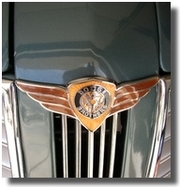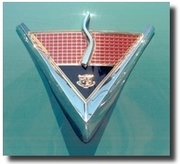Customer CarsMr. D. Upton's '37 Dodge. Enameled emblem restoration by Emblemagic. Mr. J. Irwin's '52 Studebaker. Plastic insert emblem restoration by Emblemagic. Hemmings Articles |
Beautiful BadgesHemmings Motor News - NOVEMBER 1, 2003 - BY MARK J. MCCOURT The ''emblemanic'' hobby of collecting old badgesLike jewels and furs, the earliest automobiles were expensive personal
accessories for the Emblems come in many shapes and sizes, having been used on grilles, hoods and trunk lids, as coachwork badges and more. They were made of enameled or cast metal and clear or colored plastic with metal or foil inserts. A common misconception is to refer to an enameled emblem as a cloisonné. Ray Geschke, president of the Emblemagic Company of Grand River, Ohio, says, "Cloisonné is when thin silver wires are attached to a metal base to separate colors of hard-fired vitreous enamel, and it is used when making jewelry. The way car badges are made is called champlevé, when a copper base is stamped, engraved or etched with a design, and the recessed areas are filled with powdered glass and baked. It is then nickel- or chrome-plated and buffed." Ray also says that some old badges were coated in real gold; others used copper alloy bases; early Bentley emblems were made of "German silver," which was an amalgamation of 65% copper, 18% nickel and 17% zinc, and they could be polished without requiring chrome plating. Another type of metal badge is the painted cast unit, where an emblem is stamped, cast or etched with a design and simply painted, such as the type used on late-model MGBs. The plastic emblems that replaced their metal counterparts came into favor in the late 1940s when plastic usage was becoming widespread. They were reverse-formed, meaning that the three-dimensional designs that appear to float in plastic were molded in the underside and painted or inset with foil, giving them the appearance of metal under glass. Hundreds of marques came and went in the first three decades of the automobile, and nearly all of the rare and unusual emblems from defunct brands are collectible. Obscure nameplates like Berkshire, Firestone-Columbus, Monitor, National and Premier are treasures; better-known marques like De Soto, Franklin, Kaiser, Packard or Studebaker are easier to locate and are great collection material. Antique emblems from contemporary marques can be very interesting also, such as Ford's blue oval, Cadillac's original crest or Plymouth's sailing ship. Old emblems can be found in all sorts of places, from abandoned cars in fields and junkyards to catch-all boxes or displays at swap meets and flea markets. The Internet offers many resources for collectors, and emblems are sold through sites with ties to automobilia, parts, restorations and others. "I bought a lot of emblems when I was in people's houses looking at literature collections, because people who collect emblems tend to collect other kinds of automobilia," says Walter Miller, owner of the autolit.com website and founder of the original Syracuse, New York, Museum of Automobile History. Emblem collectors often duplicate parts of their collection in order to find the cleanest examples, so they are great sources of interesting badges. And of course, the "Services Offered" and "Automobilia" pages of Hemmings are always good places to look. Common original emblems can trade hands for under $10, but rare examples in excellent condition can bring far more. "I would display the badges I acquired on old radiator stone guards, which was a popular thing to do in the 1950s and '60s," Walter says. Ray adds that, although a collector may be tempted to remove the original mounting posts or drill holes to make it easier to display emblems, it is important to leave them as original as possible so they retain their appeal for car enthusiasts and emblem collectors alike. "You would do well to start collecting the common makes you see around, to get familiar with emblems," advises Ray. "You'll find that this hobby is a seat-of-the-pants thing with no price guides-the emblems are worth whatever the market will bear. When you get more expert, go for the more exotic brands." Starting with Ford, Pontiac, or Chrysler badges may lead to an interest in specialty collecting obscure early American or imported car or truck badges, or those of a particular year, shape or color; the only limits are your time and willingness to search. So the next time you see an attractive or unusual old badge for sale, buy it, but beware...collecting can be addictive, and you may become an emblemaniac! Courtesy Hemmings Motor News |
| Copyright © . The Emblemagic Co All Rights Reserved. |
|
|





